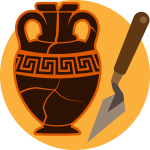Surprising Discoveries
Henry Fairfield Osborn described two incomplete Psittacosaurus skeletons found in Mongolia during the Central Asiatic Expedition of 1922. Osborn originally thought that the fossils belonged to two different species of dinosaurs. He later realized that they were both Psittacosaurus specimens. During this expedition, Osborn also found a rock that contained what he thought were only a few Psittacosaurus bones. When this fossil was prepared back at the Museum, the scientists discovered two young Psittacosaurus skulls. Paleontologists believe he stumbled upon a Psittacosaurus nest.
Scientific Name: Psittacosaurus mongoliensis
Pronunciation: sit-a-CO-saw-rus
Meaning: "parrot lizard"
Locality Found: Asia
Age: Early Cretaceous, 119 to 97.5 million years ago
Length: 1.8 meters (6 feet) long
Weight: 23 to 80 kilograms (50 to 175 pounds)
Characteristics: small, primitive ceratopian with a toothless parrot-like beak; it probably swallowed stones to grind up plants that it ate

Paleontologists believe that Psittacosaurus used its tough, hooked beak to eat:
carrots
small snakes
cycads and other green plants
Correct!
Psittacosaurus used its strong beak to cut up tough plant food just like other ceratopians.
Why was the Psittacosaurus named "parrot lizard"?
it squawked like a macaw
it had a horny parrot-like beak
it had beautiful feathers
Correct!
Psittacosaurus had a parrot-like beak, a common characteristic among ceratopians.
All ceratopian dinosaurs have a large bony frill, a parrot-like beak, and walked on all four legs.
Fiction
Psittacosaurus is a ceratopian dinosaur that walked on two legs and lacked a large bony frill.




 Biodiversity
Biodiversity
 Brain
Brain
 Genetics
Genetics
 Marine BiOLogy
Marine BiOLogy
 MicrobiOLogy
MicrobiOLogy
 PaleontOLogy
PaleontOLogy
 ZoOLogy
ZoOLogy
 AnthropOLogy
AnthropOLogy
 ArchaeOLogy
ArchaeOLogy
 Astronomy
Astronomy
 Climate Change
Climate Change
 Earth
Earth
 Physics
Physics
 Water
Water
